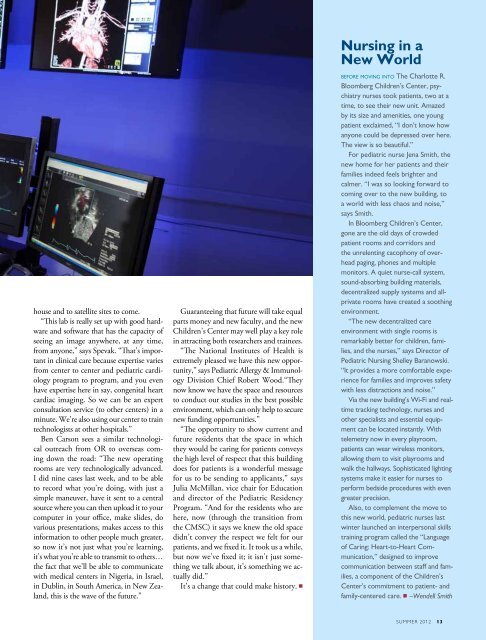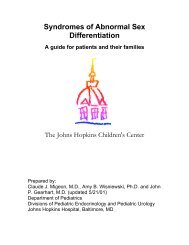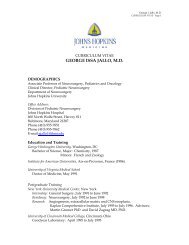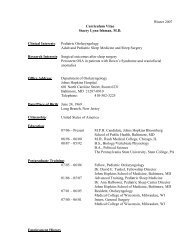Meals “at Your request” - Johns Hopkins Children's Center
Meals “at Your request” - Johns Hopkins Children's Center
Meals “at Your request” - Johns Hopkins Children's Center
Create successful ePaper yourself
Turn your PDF publications into a flip-book with our unique Google optimized e-Paper software.
house and to satellite sites to come.<br />
“This lab is really set up with good hardware<br />
and software that has the capacity of<br />
seeing an image anywhere, at any time,<br />
from anyone,” says Spevak. “That’s important<br />
in clinical care because expertise varies<br />
from center to center and pediatric cardiology<br />
program to program, and you even<br />
have expertise here in say, congenital heart<br />
cardiac imaging. So we can be an expert<br />
consultation service (to other centers) in a<br />
minute. We’re also using our center to train<br />
technologists at other hospitals.”<br />
Ben Carson sees a similar technological<br />
outreach from OR to overseas coming<br />
down the road: “The new operating<br />
rooms are very technologically advanced.<br />
I did nine cases last week, and to be able<br />
to record what you’re doing, with just a<br />
simple maneuver, have it sent to a central<br />
source where you can then upload it to your<br />
computer in your office, make slides, do<br />
various presentations, makes access to this<br />
information to other people much greater,<br />
so now it’s not just what you’re learning,<br />
it’s what you’re able to transmit to others…<br />
the fact that we’ll be able to communicate<br />
with medical centers in Nigeria, in Israel,<br />
in Dublin, in South America, in New Zealand,<br />
this is the wave of the future.”<br />
Guaranteeing that future will take equal<br />
parts money and new faculty, and the new<br />
Children’s <strong>Center</strong> may well play a key role<br />
in attracting both researchers and trainees.<br />
“The National Institutes of Health is<br />
extremely pleased we have this new opportunity,”<br />
says Pediatric Allergy & Immunology<br />
Division Chief Robert Wood.“They<br />
now know we have the space and resources<br />
to conduct our studies in the best possible<br />
environment, which can only help to secure<br />
new funding opportunities.”<br />
“The opportunity to show current and<br />
future residents that the space in which<br />
they would be caring for patients conveys<br />
the high level of respect that this building<br />
does for patients is a wonderful message<br />
for us to be sending to applicants,” says<br />
Julia McMillan, vice chair for Education<br />
and director of the Pediatric Residency<br />
Program. “And for the residents who are<br />
here, now (through the transition from<br />
the CMSC) it says we knew the old space<br />
didn’t convey the respect we felt for our<br />
patients, and we fixed it. It took us a while,<br />
but now we’ve fixed it; it isn’t just something<br />
we talk about, it’s something we actually<br />
did.”<br />
It’s a change that could make history. n<br />
Nursing in a<br />
New World<br />
before moving into The Charlotte R.<br />
Bloomberg Children’s <strong>Center</strong>, psychiatry<br />
nurses took patients, two at a<br />
time, to see their new unit. Amazed<br />
by its size and amenities, one young<br />
patient exclaimed, “i don’t know how<br />
anyone could be depressed over here.<br />
The view is so beautiful.”<br />
For pediatric nurse Jena Smith, the<br />
new home for her patients and their<br />
families indeed feels brighter and<br />
calmer. “i was so looking forward to<br />
coming over to the new building, to<br />
a world with less chaos and noise,”<br />
says Smith.<br />
in Bloomberg Children’s <strong>Center</strong>,<br />
gone are the old days of crowded<br />
patient rooms and corridors and<br />
the unrelenting cacophony of overhead<br />
paging, phones and multiple<br />
monitors. A quiet nurse-call system,<br />
sound-absorbing building materials,<br />
decentralized supply systems and allprivate<br />
rooms have created a soothing<br />
environment.<br />
“The new decentralized care<br />
environment with single rooms is<br />
remarkably better for children, families,<br />
and the nurses,” says Director of<br />
Pediatric nursing Shelley Baranowski.<br />
“it provides a more comfortable experience<br />
for families and improves safety<br />
with less distractions and noise.”<br />
via the new building’s wi-Fi and realtime<br />
tracking technology, nurses and<br />
other specialists and essential equipment<br />
can be located instantly. with<br />
telemetry now in every playroom,<br />
patients can wear wireless monitors,<br />
allowing them to visit playrooms and<br />
walk the hallways. Sophisticated lighting<br />
systems make it easier for nurses to<br />
perform bedside procedures with even<br />
greater precision.<br />
Also, to complement the move to<br />
this new world, pediatric nurses last<br />
winter launched an interpersonal skills<br />
training program called the “Language<br />
of Caring: Heart-to-Heart Communication,”<br />
designed to improve<br />
communication between staff and families,<br />
a component of the Children’s<br />
<strong>Center</strong>’s commitment to patient- and<br />
family-centered care. n –Wendell Smith<br />
Summer 2012 13





